engine SSANGYONG KORANDO 2013 Manual PDF
[x] Cancel search | Manufacturer: SSANGYONG, Model Year: 2013, Model line: KORANDO, Model: SSANGYONG KORANDO 2013Pages: 1336, PDF Size: 92.18 MB
Page 322 of 1336
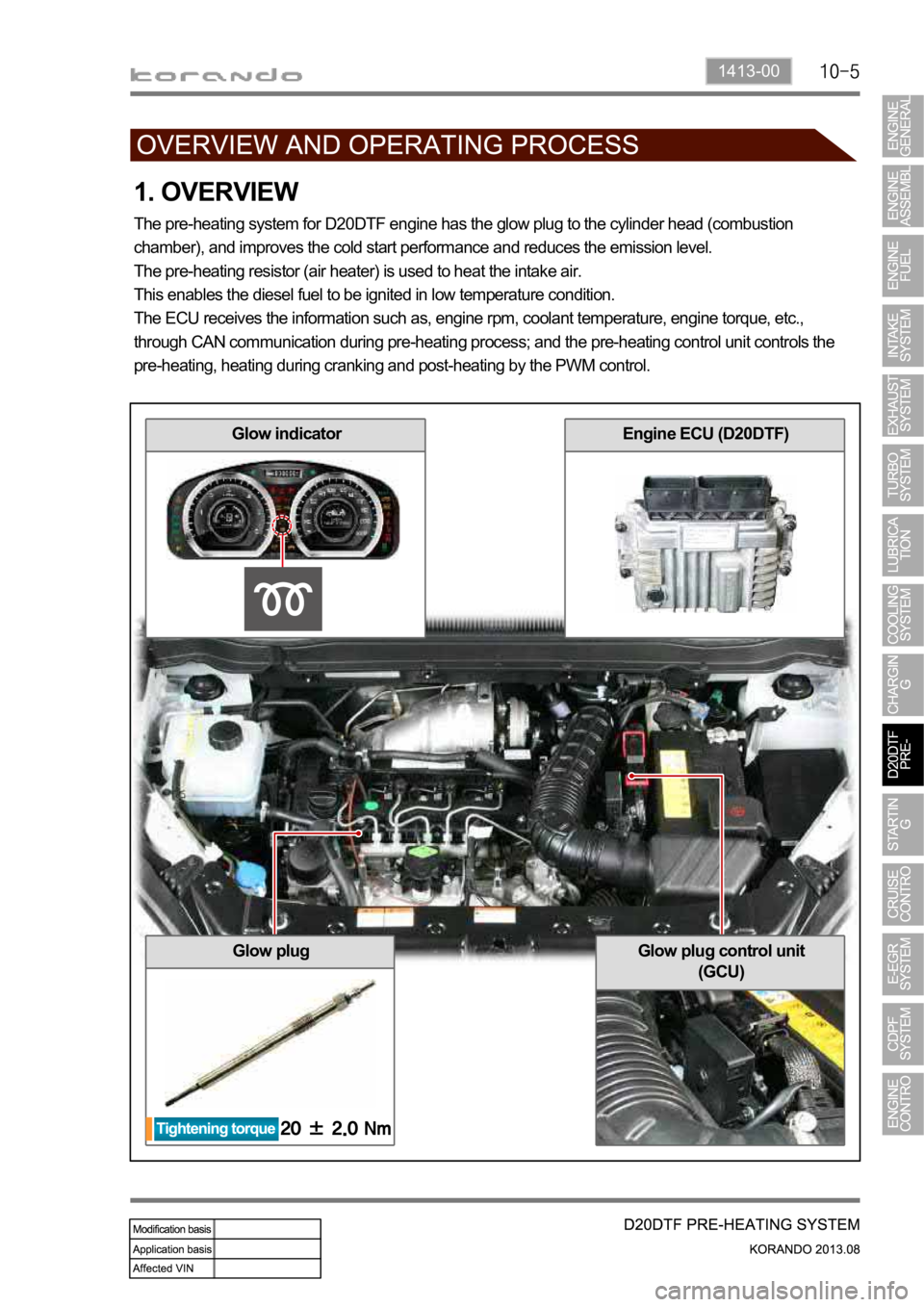
1413-00
1. OVERVIEW
The pre-heating system for D20DTF engine has the glow plug to the cylinder head (combustion
chamber), and improves the cold start performance and reduces the emission level.
The pre-heating resistor (air heater) is used to heat the intake air.
This enables the diesel fuel to be ignited in low temperature condition.
The ECU receives the information such as, engine rpm, coolant temperature, engine torque, etc.,
through CAN communication during pre-heating process; and the pre-heating control unit controls the
pre-heating, heating during cranking and post-heating by the PWM control.
Glow plugGlow plug control unit
(GCU)
Glow indicatorEngine ECU (D20DTF)
Page 327 of 1336
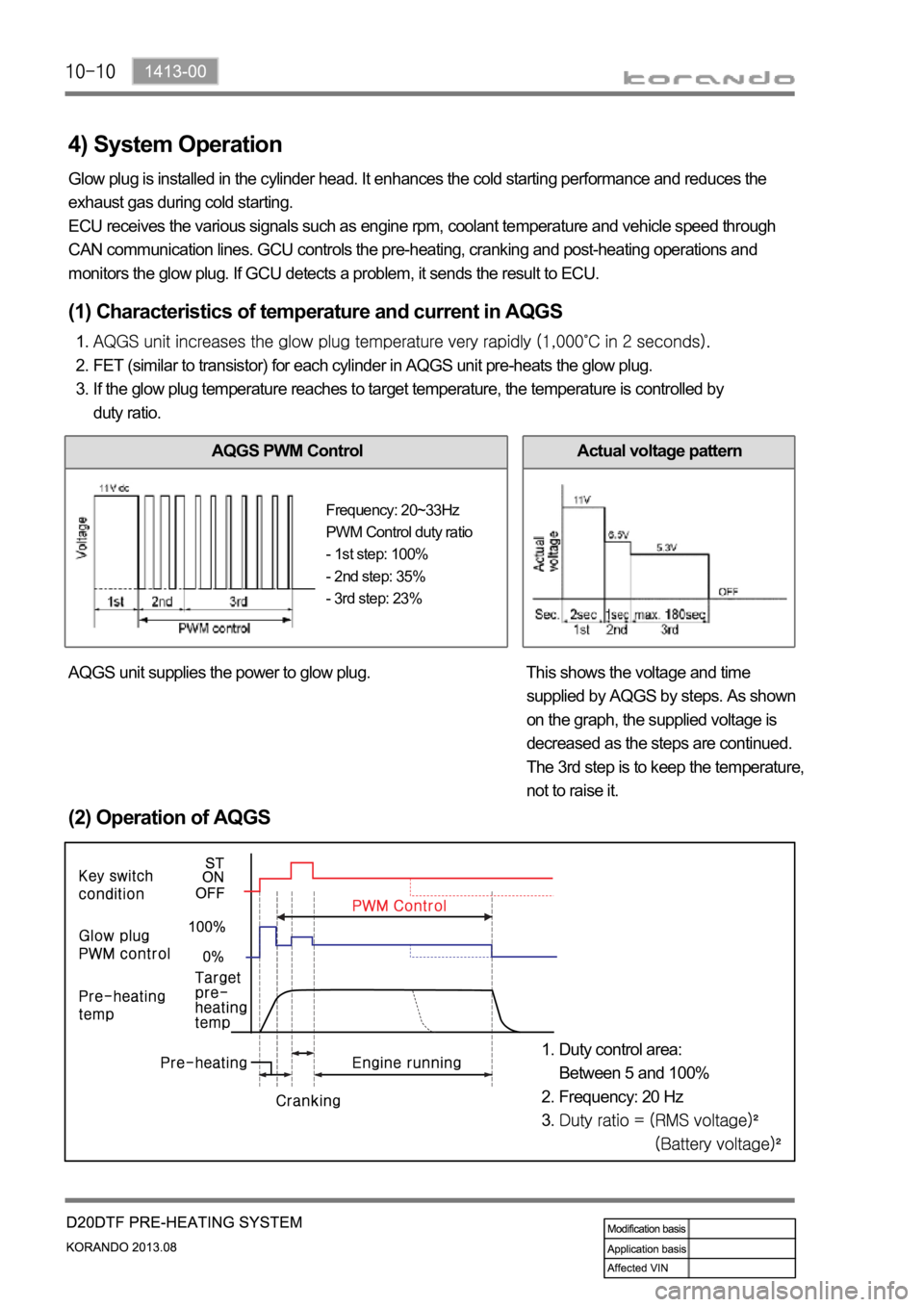
4) System Operation
Glow plug is installed in the cylinder head. It enhances the cold starting performance and reduces the
exhaust gas during cold starting.
ECU receives the various signals such as engine rpm, coolant temperature and vehicle speed through
CAN communication lines. GCU controls the pre-heating, cranking and post-heating operations and
monitors the glow plug. If GCU detects a problem, it sends the result to ECU.
(2) Operation of AQGS
Duty control area:
Between 5 and 100%
Frequency: 20 Hz1.
2.
3.
(1) Characteristics of temperature and current in AQGS
FET (similar to transistor) for each cylinder in AQGS unit pre-heats the glow plug.
If the glow plug temperature reaches to target temperature, the temperature is controlled by
duty ratio. 1.
2.
3.
AQGS PWM ControlActual voltage pattern
AQGS unit supplies the power to glow plug. This shows the voltage and time
supplied by AQGS by steps. As shown
on the graph, the supplied voltage is
decreased as the steps are continued.
The 3rd step is to keep the temperature,
not to raise it.
Frequency: 20~33Hz
PWM Control duty ratio
- 1st step: 100%
- 2nd step: 35%
- 3rd step: 23%
Page 329 of 1336

During cranking: Step 2 and step 3
Step 2: If the ECU receives the cranking signal after pre-heating (step 1), the GCU supplies the 1.
2.
Under fixed temperature: The AQGS unit supplies power for 30 seconds (Step 1 + Step 3) if no
cranking signal is received after the step 1.
During cranking: The step 3 is started after the step 2. *
*
Post-glow: Step 4:
The post-heating is for reducing HC/CO after the engine is started. If the time for post-heating exceeds
180 sec., the GCU unit cuts off the power to each glow plug even if there is preheating request from the
engine ECU.
Emergency glow
If no CAN signal is received for 4 seconds from the engine ECU after the IGN ON signal is input, the
GCU performs emergency preheating (Step 3) for 30 seconds.
Page 331 of 1336
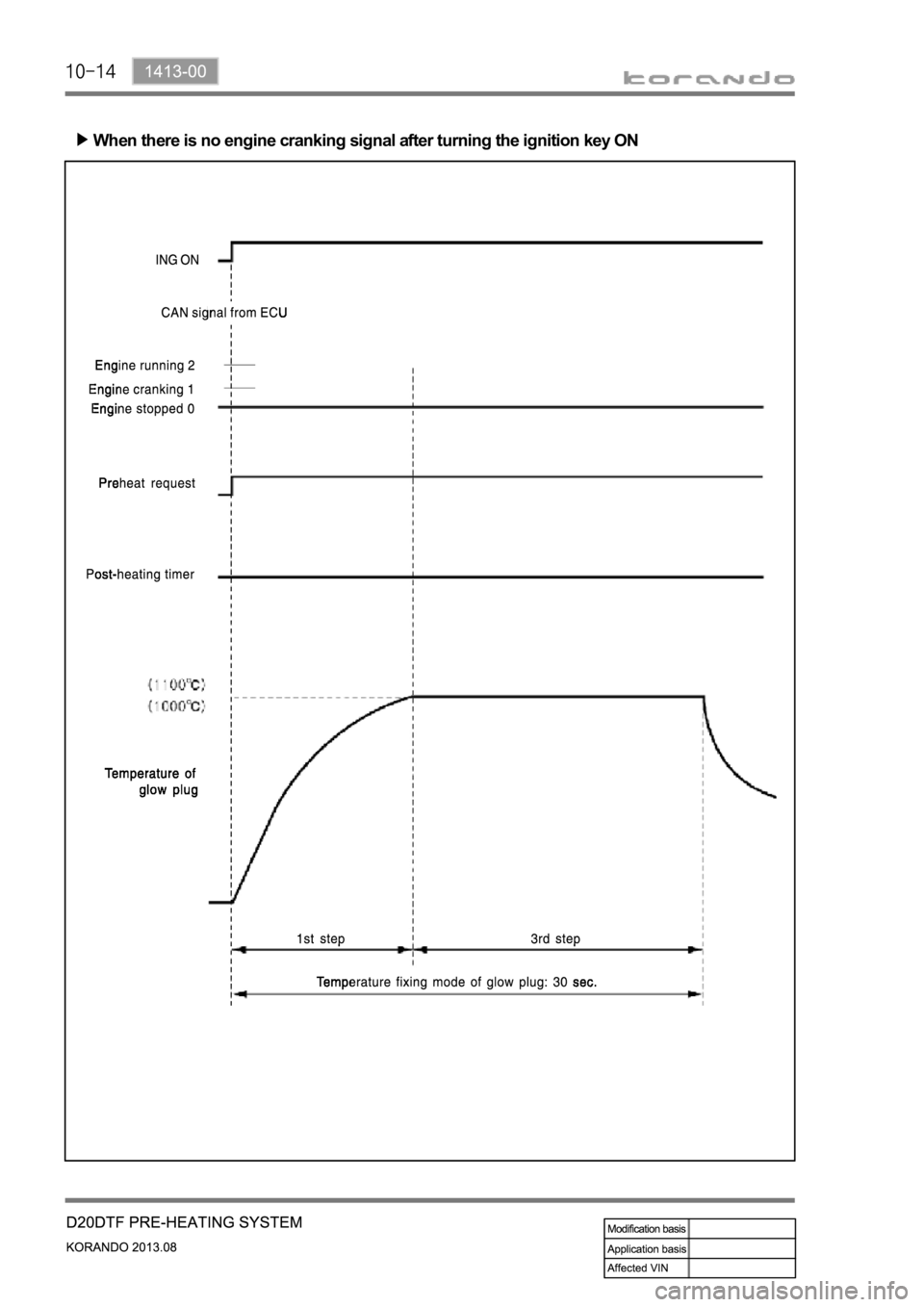
When there is no engine cranking signal after turning the ignition key ON
Page 333 of 1336
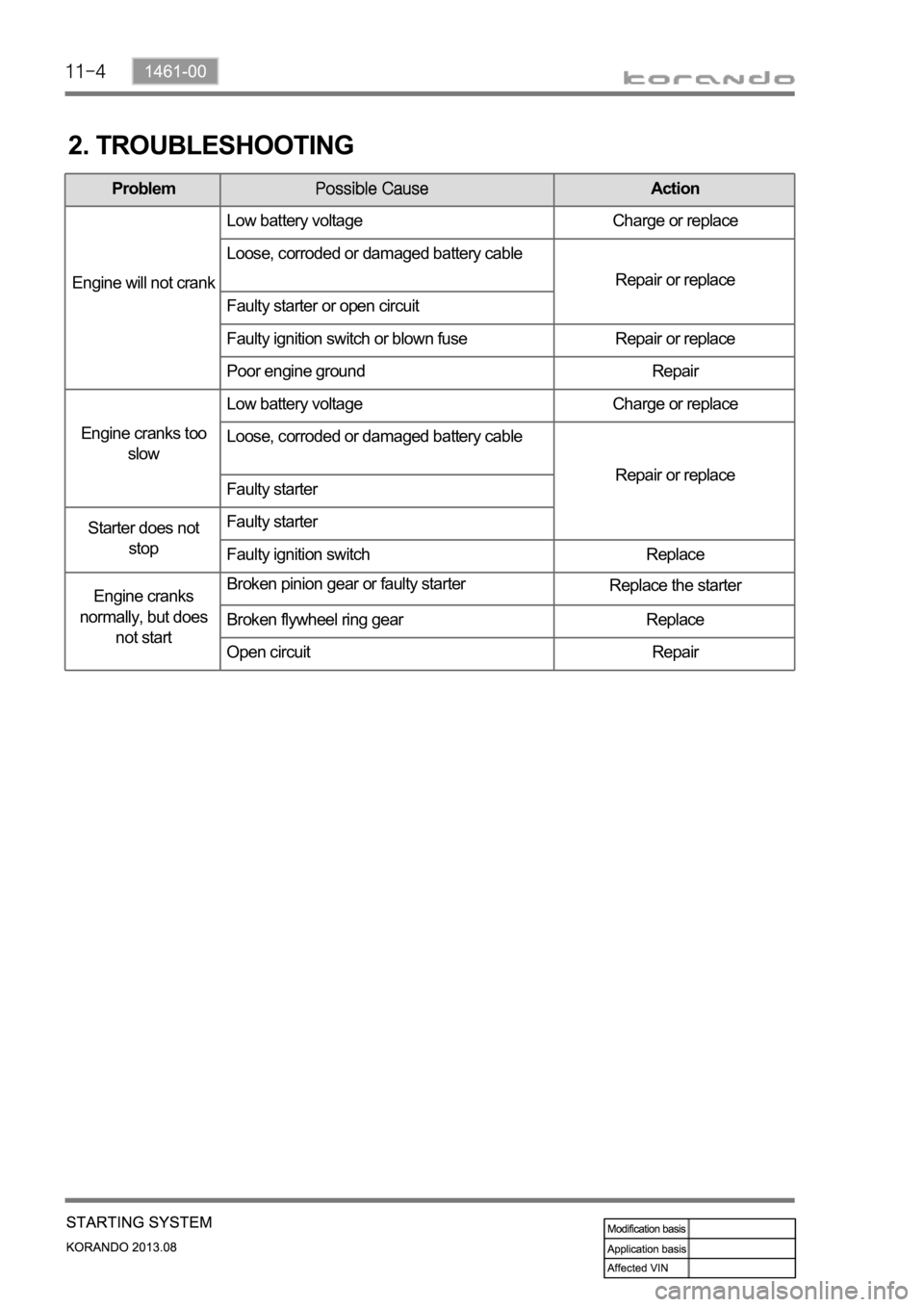
2. TROUBLESHOOTING
ProblemAction
Engine will not crankLow battery voltage Charge or replace
Loose, corroded or damaged battery cable
Repair or replace
Faulty starter or open circuit
Faulty ignition switch or blown fuse Repair or replace
Poor engine ground Repair
Engine cranks too
slowLow battery voltage Charge or replace
Loose, corroded or damaged battery cable
Repair or replace
Faulty starter
Starter does not
stopFaulty starter
Faulty ignition switch Replace
Engine cranks
normally, but does
not startBroken pinion gear or faulty starter
Replace the starter
Broken flywheel ring gear Replace
Open circuit Repair
Page 334 of 1336
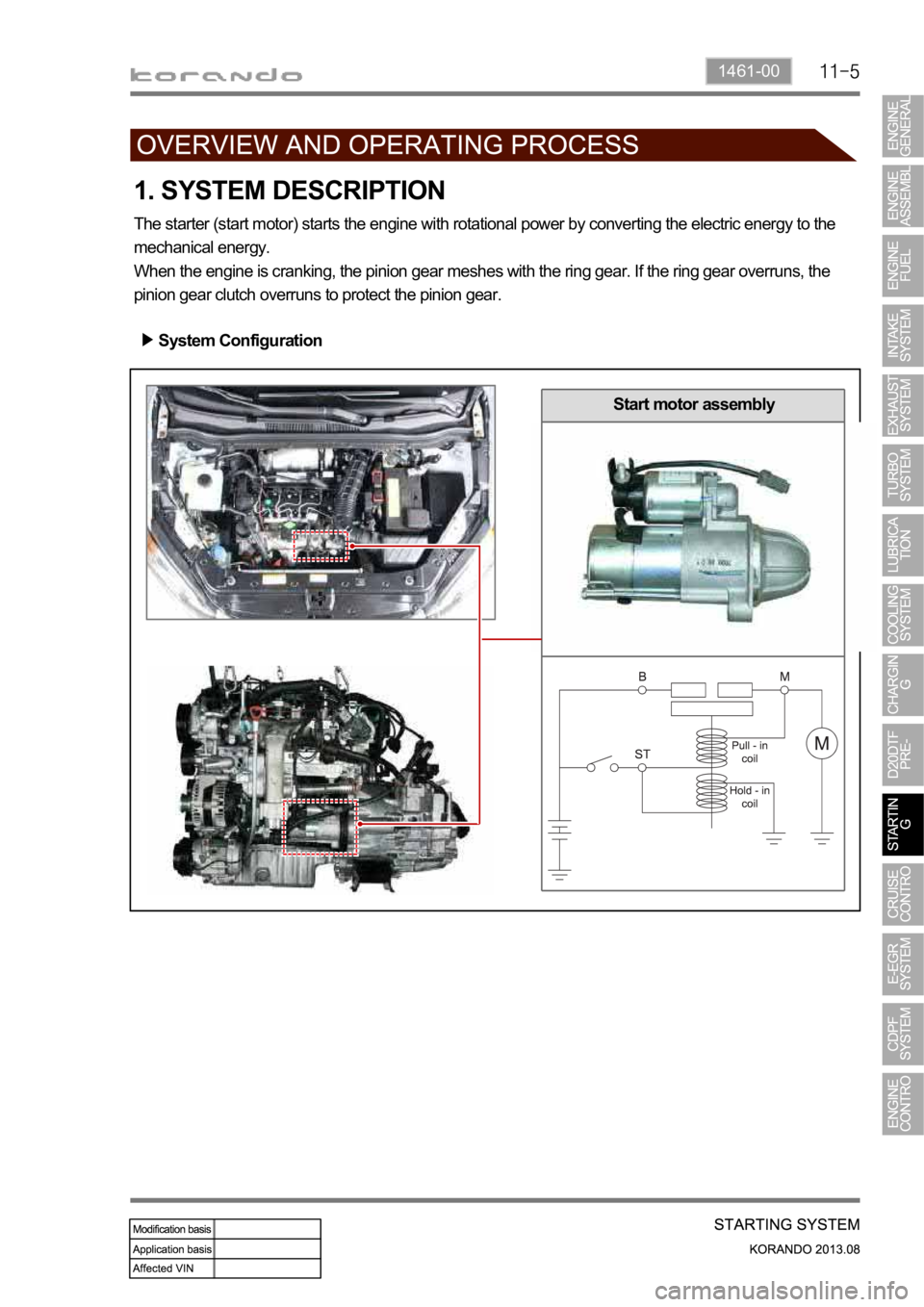
1461-00
Start motor assembly
1. SYSTEM DESCRIPTION
The starter (start motor) starts the engine with rotational power by converting the electric energy to the
mechanical energy.
When the engine is cranking, the pinion gear meshes with the ring gear. If the ring gear overruns, the
pinion gear clutch overruns to protect the pinion gear.
System Configuration
Page 335 of 1336
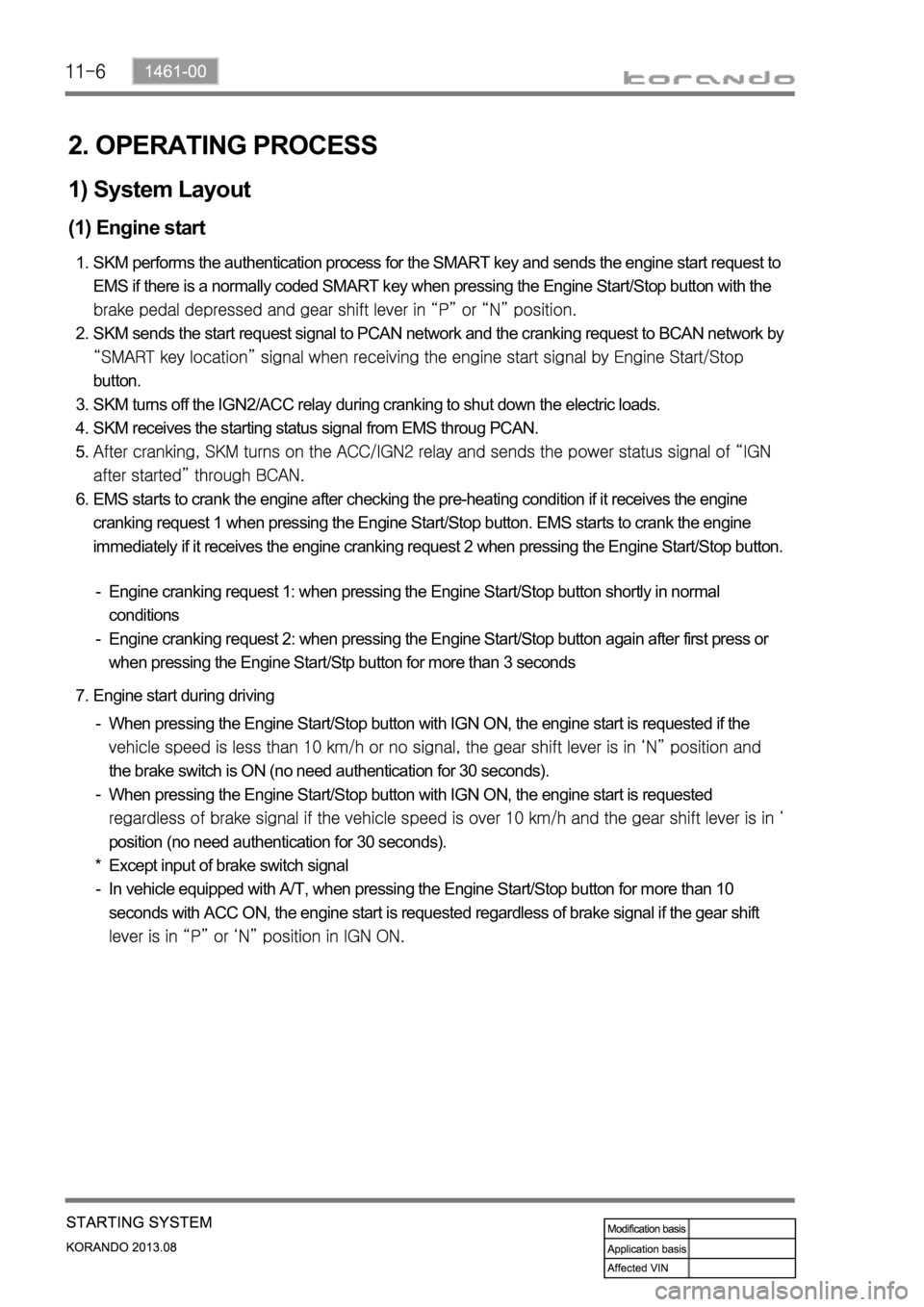
2. OPERATING PROCESS
1) System Layout
(1) Engine start
SKM performs the authentication process for the SMART key and sends the engine start request to
EMS if there is a normally coded SMART key when pressing the Engine Start/Stop button with the
SKM sends the start request signal to PCAN network and the cranking request to BCAN network by
button.
SKM turns off the IGN2/ACC relay during cranking to shut down the electric loads.
SKM receives the starting status signal from EMS throug PCAN.
EMS starts to crank the engine after checking the pre-heating condition if it receives the engine
cranking request 1 when pressing the Engine Start/Stop button. EMS starts to crank the engine
immediately if it receives the engine cranking request 2 when pressing the Engine Start/Stop button. 1.
2.
3.
4.
5.
6.
Engine cranking request 1: when pressing the Engine Start/Stop button shortly in normal
conditions
Engine cranking request 2: when pressing the Engine Start/Stop button again after first press or
when pressing the Engine Start/Stp button for more than 3 seconds -
-
Engine start during driving 7.
When pressing the Engine Start/Stop button with IGN ON, the engine start is requested if the
the brake switch is ON (no need authentication for 30 seconds).
When pressing the Engine Start/Stop button with IGN ON, the engine start is requested
position (no need authentication for 30 seconds).
Except input of brake switch signal
In vehicle equipped with A/T, when pressing the Engine Start/Stop button for more than 10
seconds with ACC ON, the engine start is requested regardless of brake signal if the gear shift
-
-
*
-
Page 345 of 1336

8530-00
2. CONFIGURATION
1) Circuit Diagram
The engine ECU detects the operating conditions of cruise control system, and monitors the braking
performance, vehicle speed, road conditions and ESP system operation. If the engine ECU determines
that there are not any problem to drive in cruise control mode, the vehicle can be operated by cruise
switch signals (decelerating, accelerating, cruising).
Page 347 of 1336
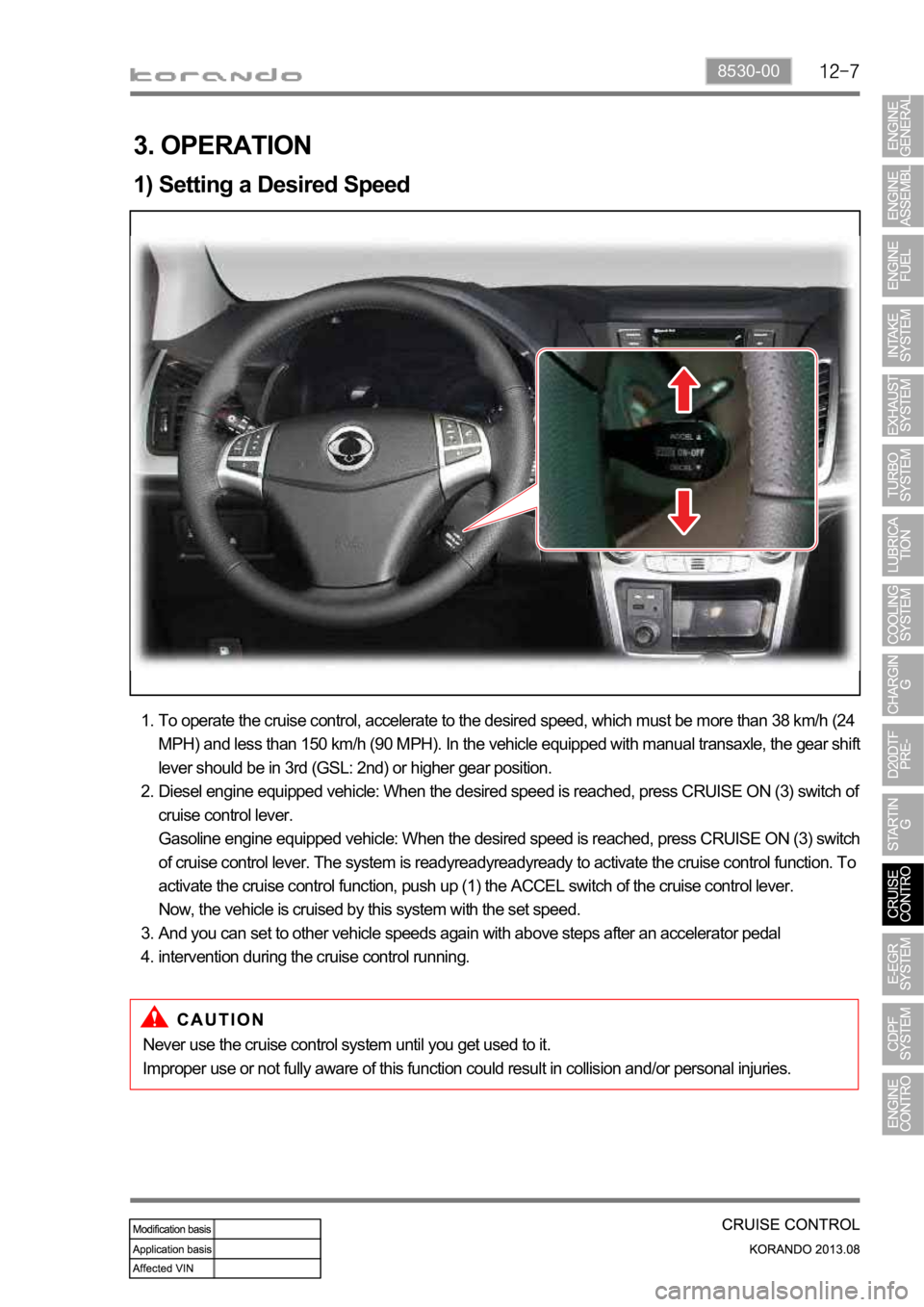
8530-00
3. OPERATION
1) Setting a Desired Speed
To operate the cruise control, accelerate to the desired speed, which must be more than 38 km/h (24
MPH) and less than 150 km/h (90 MPH). In the vehicle equipped with manual transaxle, the gear shift
lever should be in 3rd (GSL: 2nd) or higher gear position.
Diesel engine equipped vehicle: When the desired speed is reached, press CRUISE ON (3) switch of
cruise control lever.
Gasoline engine equipped vehicle: When the desired speed is reached, press CRUISE ON (3) switch
of cruise control lever. The system is readyreadyreadyready to activate the cruise control function. To
activate the cruise control function, push up (1) the ACCEL switch of the cruise control lever.
Now, the vehicle is cruised by this system with the set speed.
And you can set to other vehicle speeds again with above steps after an accelerator pedal
intervention during the cruise control running. 1.
2.
3.
4.
Never use the cruise control system until you get used to it.
Improper use or not fully aware of this function could result in collision and/or personal injuries.
Page 353 of 1336
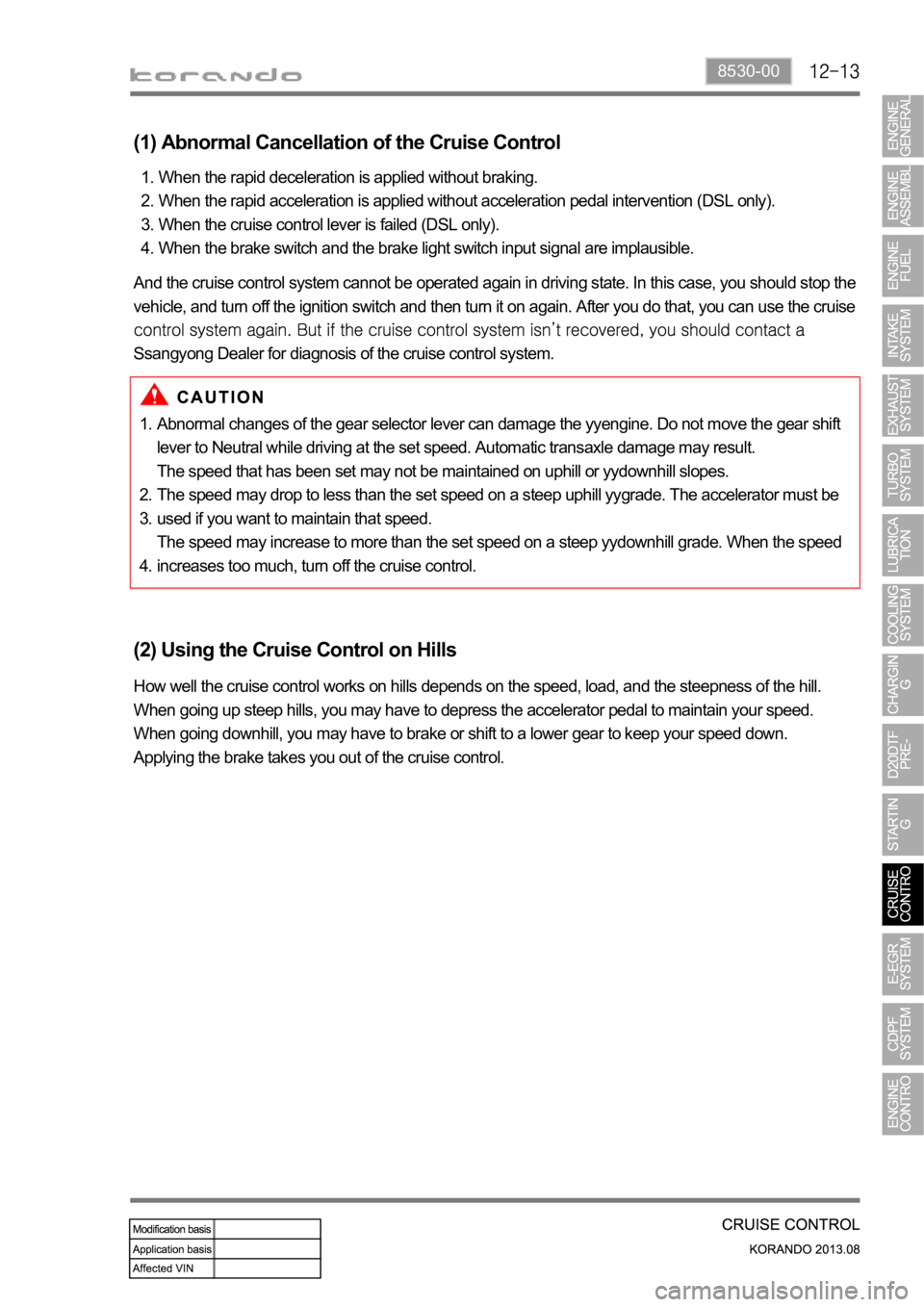
8530-00
Abnormal changes of the gear selector lever can damage the yyengine. Do not move the gear shift
lever to Neutral while driving at the set speed. Automatic transaxle damage may result.
The speed that has been set may not be maintained on uphill or yydownhill slopes.
The speed may drop to less than the set speed on a steep uphill yygrade. The accelerator must be
used if you want to maintain that speed.
The speed may increase to more than the set speed on a steep yydownhill grade. When the speed
increases too much, turn off the cruise control. 1.
2.
3.
4.
(1) Abnormal Cancellation of the Cruise Control
When the rapid deceleration is applied without braking.
When the rapid acceleration is applied without acceleration pedal intervention (DSL only).
When the cruise control lever is failed (DSL only).
When the brake switch and the brake light switch input signal are implausible. 1.
2.
3.
4.
And the cruise control system cannot be operated again in driving state. In this case, you should stop the
vehicle, and turn off the ignition switch and then turn it on again. After you do that, you can use the cruise
Ssangyong Dealer for diagnosis of the cruise control system.
(2) Using the Cruise Control on Hills
How well the cruise control works on hills depends on the speed, load, and the steepness of the hill.
When going up steep hills, you may have to depress the accelerator pedal to maintain your speed.
When going downhill, you may have to brake or shift to a lower gear to keep your speed down.
Applying the brake takes you out of the cruise control.